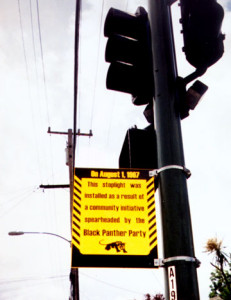Showing race equality the green light
Are road accidents a ‘race’ issue? Nearly 50 years ago in Oakland, California, a political movement ran one of its earliest campaigns on this topic – protesting against a set of traffic lights on a dangerous junction, where three children had been killed by cars. Those children were black, and the movement campaigning for road safety were the Black Panthers. The racist city authorities were not interested in reducing road deaths in black areas, but through local campaigning on a wide issue such as road safety, lights were installed on that junction in 1967.
In the UK, black and minority ethnic communities are more affected by poverty, homelessness, wealth inequality, unemployment, and ill-health. At the end of 2010, when the first of the cuts were being made in the Autumn statement, a report for the Equalities and Human Rights Commission highlighted ‘entrenched racial and social inequality’ in prisons, education, and employment. Austerity has made these worse.
Any serious political party needs policies that will tackle these problems. To do so otherwise is to say that some lives are more valuable than others. For Greens, as a party that has equality as part of its philosophical basis, race should be high on our agenda.
Greens have good policies, but have had less success at becoming a party that represents, includes and campaigns for black and minority ethnic communities.
At worst, we can fall into the trap of claiming to be ‘colour-blind’. But we simply cannot claim to be colour blind when evidence shows that Black or Asian people are far more likely to be stopped and searched by the police, that black and minority ethnic people are far more likely to be admitted to hospital with a mental illness, or that Gypsies and Travellers die 10 years younger on average.
Things have changed within the Green Party for the better. When I first joined in 2004, you could probably count the number of BAME people at a Party Conference on one hand. Of the 100 or so of my fellow Green councillors during my stint in office (2008-12), very few were from an ethnic minority.
That is beginning to change. I think most of us acknowledge that the Greens need to be more representative of the communities we work for. Thanks in part to the Green surge and the amazing work of the Young Greens, we have more members from black and ethnic minority communities, and more of them are interested in standing for political office. However, we need to go much further.
At the grassroots we need to change so that our local parties reflect their local communities. As a party, we need to support that change and put time and resources into it. We also need our leadership at all levels to be more diverse, from candidates to national figures. Fortunately there’s a model for doing this in the Young Greens 30 under 30 programme. We should also monitor, and put in place quotas for candidates – these have worked well to ensure greater gender representation in other countries and we shouldn’t shy away from using what works.
Greens have a chance to build something real, a grassroots party that represents black and ethnic minority communities, and which tackles local problems and systemic injustices.
This article is part of a series that Bright Green is running on the topic of race and the Green Party. See past contributions by Lester Holloway here and by Violeta Vajda here.





Leave a Reply